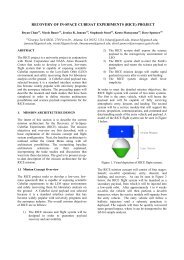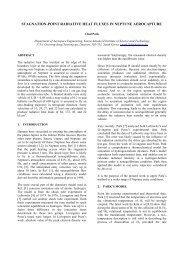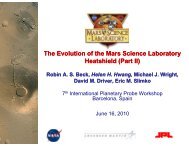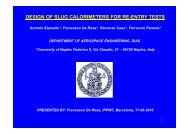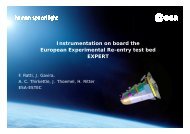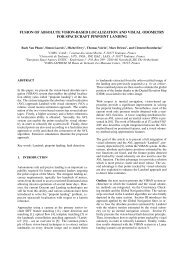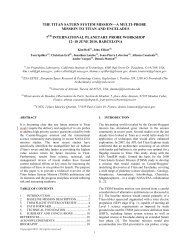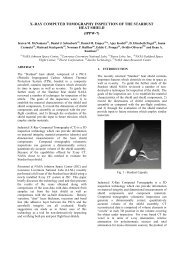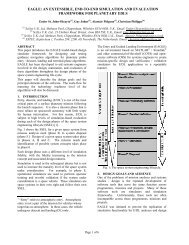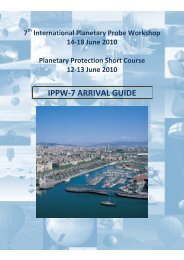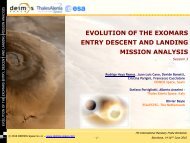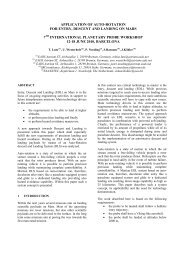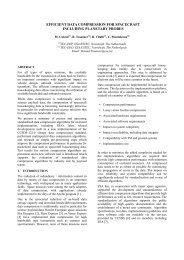Final Program - International Planetary Probe Workshop
Final Program - International Planetary Probe Workshop
Final Program - International Planetary Probe Workshop
You also want an ePaper? Increase the reach of your titles
YUMPU automatically turns print PDFs into web optimized ePapers that Google loves.
7 th <strong>International</strong> <strong>Planetary</strong> <strong>Probe</strong> <strong>Workshop</strong><br />
14-18 June 2010<br />
WORKSHOP PROGRAM
HOST ORGANISATIONS<br />
CTAE is a non-profit foundation established in 2005 as a technology<br />
centre dedicated to supporting the regional aerospace and space<br />
industry. The Board includes the Generalitat of Catalunya (the<br />
government of the autonomous region of Catalunya), 9 aerospace<br />
companies, and the Universitat Politècnica de Catalunya (UPC). CTAE<br />
works in Robotics and Advanced Autonomy, Safety-critical Software and<br />
Control, Navigation and Communications, Remote Sensing, and Vehicles<br />
and Environment. R&D projects are delivered at all levels from local<br />
clients to international consortia with ESA, the Galileo Supervisory<br />
Authority, and with the European Commission.<br />
BAIE is a platform created in November 2000 that aims to promote the<br />
Metropolitan Region of Barcelona and Catalonia as competitive settings<br />
for the activities related to the aeronautical and space industry. It was<br />
an initiative of the Ajuntament (City Hall) of Barcelona, that was joined<br />
by the autonomous government — Generalitat of Catalonia (through the<br />
Department of Industry and its company CIDEM), the Spanish<br />
government (through the Ministry of Science and Technology), and a<br />
small group of companies and organisations as founding members.<br />
Today BAIE has around 80 members.<br />
DEIMOS Space is a company funded in 2001 whose Institutional Space<br />
business is mainly oriented to ESA programmes. Atmospheric flight<br />
represents an area of excellence for DEIMOS. Participating to several<br />
System studies DEIMOS has handled Mission Analysis, Flight Mechanics<br />
and GNC combined with FDI for Launchers, Capsules, Lifting bodies and<br />
Winged vehicles. Remarkably, in the area of planetary probes and<br />
experimental vehicles, DEIMOS is today leading the EDL Mission Analysis<br />
& Design activities in EXOMARS Phase B and the Mission Analysis of the<br />
Intermediate eXperimental Vehicle (IXV) in Phase C2.<br />
The Ajuntament de Barcelona (City Hall) is formed by 41 elected city<br />
councillors and is organised in two levels: a political, with elected city<br />
councillors, and an executive, which administers the programs and<br />
executes the decisions taken on the political level. The Comissió de<br />
Govern (Government Commission) is the executive branch and is led by<br />
the Mayor, currently Jordi Hereu. The seat of the city council is on the<br />
Plaça Sant Jaume, opposite the seat of Generalitat de Catalunya, and is<br />
the venue for the IPPW-7 welcome reception. The reception is kindly<br />
sponsored by the Ajuntament de Barcelona.<br />
CIMNE (Centre Internacional de Mètodes Numèrics en Enginyeria) is a<br />
research centre created in 1987 by initiative of the Universitat<br />
Politècnica de Catalunya (UPC) and the Generalitat de Catalunya. CIMNE<br />
specializes in the development and dissemination of numerical methods<br />
and software for engineering sciences.<br />
CIMNE also operates a congress office, and provides technical and<br />
administrative secretariat services to workshops around the world,<br />
including IPPW-7.
IPPW-7 SPONSORS<br />
SUPPORTING ORGANISATIONS
WELCOME<br />
Welcome — both to the 7 th <strong>International</strong> <strong>Planetary</strong> <strong>Probe</strong> <strong>Workshop</strong>, and to Barcelona. This<br />
year’s event is resuming after a two-year hiatus following IPPW-6 in Atlanta in 2008. We have<br />
been overwhelmed by the enthusiastic response to our call for papers. The events of the past<br />
two years have generated an outstanding set of presentations and posters that you will<br />
encounter in the next four and a half days.<br />
We are pleased to welcome an international group of scientists, technologists, engineers,<br />
mission designers, and policy makers to IPPW-7. Our committees have worked very hard in<br />
organizing the logistics for the workshop, planning the program, soliciting and evaluating<br />
nominees for the Al Seiff Award, and coordinating opportunities for student participation. We<br />
are fortunate to be meeting in the beautiful city of Barcelona, Spain; all participants will have<br />
the opportunity to enjoy its exciting architecture, culture, and food.<br />
We encourage you to attend as many oral and poster sessions as possible, in order to benefit<br />
from the world-wide planetary probe mission experts who are attending IPPW-7. We were so<br />
impressed by the abstracts submitted for this workshop that we’ve scheduled two poster<br />
sessions to accommodate both the originally-submitted poster abstracts and those oral<br />
presentations that could not be accommodated in the schedule, and whose sponsors have<br />
agreed to present in a poster format.<br />
Since IPPW-7 is indeed a workshop, we also encourage you to take advantage of the numerous<br />
opportunities during coffee breaks, lunches and social activities to build collaborative<br />
partnerships with other workshop participants. In addition, the IPPW-7 sponsors have funded a<br />
number of students who would be interested in meeting the working planetary probe<br />
participants to gain a better understanding of how to build a future career in this exciting field.<br />
A couple of tips are in order for maximizing your experience at the workshop. Because of the<br />
wealth of abstracts selected for presentation, we will hold parallel sessions on Thursday, 17<br />
June. Our conveners will coordinate their timing so it will be possible to move back and forth<br />
between the parallel sessions in the morning and afternoon. Of interest to our student and<br />
early career attendees is a professional development session, also scheduled on Thursday.<br />
On Friday, 18 June, there will be a presentation on the plans for IPPW-8 in 2011. We encourage<br />
you to attend this talk so that you can learn about your next opportunity to join our community<br />
of planetary probe mission enthusiasts and experts.<br />
Now, let’s get started!<br />
Bernie Bienstock<br />
JPL<br />
IPPW-7 <strong>International</strong> Organizing Committee<br />
US Co-Chair<br />
Ed Chester<br />
CTAE<br />
IPPW-7 <strong>International</strong> Organizing Committee<br />
European Co-Chair;<br />
Local Organizing Committee Chair<br />
- 3 -
SCHEDULE OVERVIEW<br />
Day<br />
14/6 15/6 16/6 17/6 18/6<br />
Mon Tue Wed Thu (PARALLEL SESSIONS) Fri<br />
Morning<br />
Session 1:<br />
Opening;<br />
Outlook for<br />
<strong>Probe</strong><br />
Missions<br />
Session 3:<br />
Terminal<br />
Descent<br />
Session 5:<br />
EDL<br />
Technology<br />
Development<br />
and GNC<br />
Session 6A:<br />
Entry<br />
Sensors;<br />
Payloads;<br />
Penetrators<br />
Session 6B:<br />
Drag;<br />
Aerobraking;<br />
Aerocapture<br />
Session 8:<br />
Closing<br />
Session;<br />
Awards;<br />
Panel<br />
Afternoon<br />
Session 2:<br />
<strong>Probe</strong><br />
Missions<br />
Session 4:<br />
Science from<br />
<strong>Probe</strong>s and<br />
Penetrators<br />
Field Trips<br />
Session 7A:<br />
New<br />
Technologies<br />
Session 7B:<br />
Airless Body<br />
Surface<br />
Missions<br />
Evening<br />
Welcome<br />
Reception<br />
Poster<br />
Session 1<br />
Banquet<br />
Poster Session 2<br />
IOC Dinner<br />
REGISTRATION<br />
On-site registration (collection of badge and delegate pack) can be performed at the following<br />
times:<br />
<br />
<br />
<br />
Early Registration: Sunday 13/June, Hotel Alimara, Besalú Room (IPPW Secretariat)<br />
18:00 – 20:00<br />
Main Registration: Monday 14/June, Besalú Room<br />
08:00 – 08:45<br />
Later Registration: Whenever you arrive, Besalú Room<br />
- 4 -
STUDENT PROGRAM<br />
Student Welcome Dinner<br />
Meeting Location: Agora (where most of the students will be<br />
staying) or MUNDET metro station (between Agora and Alimara)<br />
Dinner Location: Market Hotel Restaurant, c/ Compte Borrell, 68<br />
Date: Sunday, June 13<br />
Time: 7:45pm / 19:45<br />
Cost: €5<br />
The Student Dinner Social will take place Sunday evening, June 13. All students are welcome to<br />
attend. This will be a great opportunity for students to get to know each other in a relaxed<br />
atmosphere, plus there will be (almost) free food! The social will take place at a restaurant in<br />
the city centre of Barcelona. There is no dress code, but being that it will be Sunday night, it is<br />
strongly suggested to not wear T-shirts and shorts. If you plan to attend the student social,<br />
please meet at the front desk of the Agora BCN at 7:45pm (19:45). The students will travel in a<br />
group via public transportation to the restaurant in the city centre. If you are staying in Alimara,<br />
please meet at the MUNDET metro station.<br />
A very nominal charge of €5 per person will be collected from each student prior to departure<br />
from the meeting point.<br />
Professional Development Session<br />
Date: Thursday, June 17<br />
Meeting Location: Medes Room<br />
Time: 13:30 – 15:00<br />
The goal of the Professional Development session is to provide a forum for students to engage<br />
and interact with professionals on topics relevant to careers in planetary sciences, technologies<br />
and engineering. The session will include brief presentations from a panel of representatives<br />
from U.S. and European aerospace industry, academia, NASA, ESA, and a recent graduate now<br />
employed in the aerospace industry. Students will have ample opportunity to ask questions of<br />
the panelists. Specific topics of discussion include expert advice from the panelists on careers<br />
in planetary sciences and aerospace engineering, the outlook for near-term hiring and<br />
employment, different career path options, as well as lessons learned and advice.<br />
Note: Food is not allowed in the room so please eat lunch prior to arriving at the session.<br />
Student Poster/Paper Awards<br />
Date: Friday, June 18<br />
Meeting Location: Catalunya Room<br />
Time: 10:00 – 10:30<br />
A ballot will be included in the registration material for IPPW participants to vote on the<br />
student oral and poster presentations. Based on the voting outcome, awards for outstanding<br />
student presentations will be presented during the closing session on Friday.<br />
- 5 -
14 June 2010 DAY 1<br />
MONDAY<br />
MORNING<br />
Session Conveners:<br />
SESSION 1:<br />
Opening, Al Seiff Award Speakers, and the Outlook for <strong>Probe</strong> Missions<br />
<br />
<br />
<br />
B. Bienstock, NASA Jet Propulsion Laboratory (USA)<br />
E. Venkatapathy, NASA Ames Research Center (USA)<br />
M. Amato, NASA Goddard Spaceflight Center (USA)<br />
Times<br />
08:00 08:45 Delegate Registration (Besalú Room)<br />
08:45 09:00 Opening Welcome and Logistics<br />
E. Chester — Logistics<br />
G. Garcia Cuadrado — Welcome from Barcelona Aeronautics and Space Association<br />
B. Bienstock — Opening of IPPW-7<br />
09:00 09:15 Alvin Seiff Award Presentations<br />
J. Arnold<br />
09:15 09:45 Al Seiff: Thoughts About, and Lessons from, a Great Engineer<br />
M. Tauber<br />
09:45 10:15 Reflections on a Career in <strong>Planetary</strong> Science<br />
M. Tomasko<br />
10:15 10:45 Outlook for <strong>Probe</strong> and Lander Missions in ESA’s <strong>Program</strong>mes<br />
J.-P. Lebreton<br />
10:45 11:15 COFFEE BREAK<br />
(Garden)<br />
11:15 11:45 NASA Overview<br />
Doug McCuistion<br />
11:45 12:30 NASA’s Technology and Innovation <strong>Program</strong>s<br />
B. Braun<br />
12:30 13:00 Mars Sample Return Campaign – Building on the Shoulders of Missions Past and<br />
Contributing to the Eventual Human Flight to Mars<br />
F. Naderi<br />
13:00 14:30 LUNCH<br />
(Garden)<br />
- 6 -
14 June 2010 DAY 1<br />
MONDAY<br />
AFTERNOON<br />
SESSION 2:<br />
<strong>Probe</strong> Missions: Concepts and Ongoing Studies of In-situ Exploration Missions<br />
Session Conveners:<br />
<br />
<br />
<br />
W. Lee, NASA Jet Propulsion Laboratory (USA)<br />
A.-M. Schipper, Thales Alenia Space (Italy)<br />
J. Hall, NASA Jet Propulsion Laboratory (USA)<br />
Times<br />
15:00 16:00 Future Multi-<strong>Probe</strong> Missions to Titan and Enceladus<br />
K. Reh and J. Elliot<br />
16:00 16:30 Technology Development for Long Duration Mid-Cloud Level Venus Balloon<br />
J. Hall, A. Yavrouian et al.<br />
16:30 17:00 COFFEE BREAK<br />
(Garden)<br />
17:00 17:30 Venus Mobile Explorer: A Mission Concept Study for the National Research<br />
Council <strong>Planetary</strong> Decadal Survey<br />
L. Glaze, C. Baker et al.<br />
17:30 18:00 The Europa Jupiter System Mission: A Pathfinder for Future Landings in the<br />
Jupiter System<br />
O. Grasset, M. Blanc et al.<br />
18:00 18:30 Landing Site Targeting and Constraints for ExoMars 2016 Mission<br />
S. Portigliotti, M. Dumontel et al.<br />
18:30 19:00 Aerobot Autonomous Navigation And Mapping For <strong>Planetary</strong> Exploration<br />
A. Aboudan, G. Colombatti, et al.<br />
Approx. 19:30<br />
Travel by Metro to City Centre<br />
20:00 22:00 Welcome Reception at Barcelona City Hall<br />
Sponsored and hosted by City of Barcelona — details on next page.<br />
- 7 -
WELCOME RECEPTION<br />
Day: Monday 14 June 2010<br />
Times:<br />
Location:<br />
20:00 – 20:30 — Arrival<br />
20:30 – 22:00 — Reception (drinks and light refreshments)<br />
Barcelona City Hall — Ajuntament de Barcelona<br />
Address: c/ Ciutat 2,<br />
Plaça Sant Jaume (SE side, opposite the Generalitat)<br />
Dress Code:<br />
Smart Casual<br />
Arrival: A short metro ride of 10-15mins from the Hotel Alimara stop (MUNDET, Line 3)<br />
to station LICEU.<br />
250m walk via Ramblas and Carrer Ferran. Maps are available in delegate packs.<br />
Please inform us during registration of any special dietary or mobility requirements.<br />
La Casa de la Ciutat de Barcelona (City Hall), the building and headquarters of Barcelona City<br />
Council, is located in the historical centre of the city, in Plaça de Sant Jaume, facing the Palau de<br />
la Generalitat de Catalunya (the seat of the Catalan government).<br />
The construction of the Casa de la Ciutat was carried out over several centuries. The presentday<br />
main facade, on Plaça Sant Jaume, is neoclassical in style and dates to 1847, but the origin<br />
of the building was in 1369 when construction began of the Saló de Cent (Hall of the Hundred).<br />
This was the seat of Barcelona’s medieval government, the predecessor of the city council. In<br />
the side street on the left (carrer Ciutat) is the old Gothic facade from 1399, which was used as<br />
the main door until 1847.<br />
The present-day main door opens onto the courtyard, Gothic in style but with some<br />
Renaissance decorative elements. Its construction began in 1391 and it was originally accessed<br />
from the Gothic facade. On the left-hand side of the courtyard is the staircase of honour, which<br />
leads up to the Hall of the Hundred.<br />
RECEPTION SPONSORED AND HOSTED BY:<br />
- 8 -
15 June 2010 DAY 2<br />
TUESDAY<br />
MORNING<br />
SESSION 3:<br />
Terminal Descent Issues, Target Landing Site Selection, and Trajectory Reconstruction<br />
Session Conveners:<br />
<br />
<br />
<br />
A. Coustenis, Observatoire de Paris (France)<br />
T. Spilker, NASA JPL (USA)<br />
G. Chen, NASA Jet Propulsion Laboratory (USA)<br />
Times<br />
09:00 09:30 Guidance and Control for Atmospheric Entry<br />
R. Frampton et al.<br />
09:30 10:00 Scientific Objectives and Engineering Constraints of Future Titan<br />
Landing Sites<br />
R. Jaumann et al.<br />
10:00 10:30 Radio Astronomy Experiments with <strong>Planetary</strong> <strong>Probe</strong>s<br />
L. Gurvits et al.<br />
10:30 11:00 COFFEE BREAK — Sponsored by MONOCROM<br />
(Garden)<br />
11:00 11:20 MSL EDL Terminal Descent Strategy and Challenges<br />
S. Sell<br />
11:20 11:40 Terrain Safety Assessment Approach for MSL<br />
D. Kipp<br />
11:40 12:00 Reconstruction of EDL Communications for the 2007 Phoenix Mars<br />
Lander<br />
R. Kornfeld, K. Bruvold et al.<br />
12:00 12:20 Marsnext Multiple Lander Targeting Trajectory Computation And<br />
Navigation<br />
D. García Yárnoz, J.M. Sánchez Pérez<br />
12:20 12:40 Evolution of the ExoMars EDL Mission Analysis<br />
R. Haya Ramos et al.<br />
12:40 13:00 An Analysis of Illumination and Communication Conditions near<br />
Lunar South Pole based on Kaguya data<br />
B. Vanoutryve, D. De Rosa et al.<br />
13:00 14:30 LUNCH<br />
(Garden)<br />
- 9 -
15 June 2010 DAY 2<br />
TUESDAY<br />
AFTERNOON<br />
Session Conveners:<br />
SESSION 4:<br />
Science from Entry and Descent <strong>Probe</strong>s and Penetrators<br />
<br />
<br />
<br />
R. Lorenz, John Hopkins University APL (USA)<br />
R. Beebe, PDS/NMSU University (USA)<br />
J.-P. Lebreton, ESA ESTEC (Netherlands)<br />
Times<br />
14:30 15:00 Results from the Phoenix Atmospheric Structure Experiment<br />
P. Withers, D. Catling<br />
15:00 15:30 The Venus Flagship Study: Atmospheric Science From Two<br />
Descent/Landing Vehicles And Two Balloons<br />
M. Bullock, J. Hall, T. Balint<br />
15:30 16:00 The SAGE New Frontiers Mission to Venus<br />
B. Bienstock, G. Burdick<br />
16:00 16:30 COFFEE BREAK — Sponsored by MONOCROM<br />
(Garden)<br />
16:30 16:50 Science, Instrumentation, and Operations Concepts for a Titan<br />
Airplane<br />
J.W. Barnes<br />
16:50 17:10 Detection of Aerosols in <strong>Planetary</strong> Atmospheres using the New Light<br />
Aerosol Counter LOAC<br />
J.-B. Renard, G. Berthet et al.<br />
17:10 17:30 Characterizing Titan’s Haze With A Balloon-Borne<br />
Spectropolarimeter<br />
N. Silvestri, D.M. Stam et al.<br />
17:30 17:50 Investigating the Origin and Evolution of Venus with Descent <strong>Probe</strong><br />
Mass Spectrometry<br />
W. Brinckerhoff, P. Mahaffy<br />
17:50 18:10 Science-Quality Oscillators for Deep Space <strong>Probe</strong>s<br />
S. Asmar, D. Atkinson et al.<br />
18:10 18:30 A Fresh Look at the Huygens Radar Altimeter Problem: New Results<br />
and Science Opportunities<br />
R. Trautner, H. Svedhem, J.-P. Lebreton<br />
19:00 21:00 POSTER SESSION 1<br />
Poster Titles and Authors are listed on pages 11-13.<br />
- 10 -
POSTER SESSION 1<br />
Session Conveners:<br />
<br />
<br />
<br />
R. Haya Ramos, Deimos Space (Spain)<br />
D. Atkinson, University of Idaho (USA)<br />
A. Jaime, Technical University of Catalonia (Spain)<br />
Title<br />
Models Of Spectral Radiation Heat Transfer For Martian Space Vehicles<br />
Daniil Andrienko<br />
DRIFT/VISC-Distributed, Redundant, and Inherently Fault Tolerant Microprobe Concept<br />
Mark Arnold<br />
Entry <strong>Probe</strong> Missions to the Giant Planets<br />
David Atkinson<br />
Venus Intrepid Tessera Explorer (VITaL): A Mission Concept Study For The National Research Council<br />
<strong>Planetary</strong> Decacal Survey<br />
Charles Baker<br />
Venus Mobile Explorer (VME): Near-Surface Traversing with Metallic Bellows<br />
Tibor Balint<br />
Science, Instrumentation, and Operations Concepts for a Titan Airplane<br />
Jason W. Barnes<br />
Earth Entry Vehicle Impact Analysis<br />
Nicole Bauer<br />
Testing and Verification for the SOAREX-7 TDRV Flight<br />
Kenny Boronowsky<br />
A UHF High Power Transceiver System With Wireless Interface Modules For High Altitude Data<br />
Acquisition And Control<br />
Anna Camery<br />
The Recovery Of In-Space Cubesat Experiments (RICE) Nanosatellite<br />
Bryan Chan<br />
Atmospheric Sensitivities and Characterization Efforts for the Mars Science Laboratory Entry,<br />
Descent, and Landing System<br />
Allen Chen<br />
Development of Design and Production Processes for a Block-Ablator Heatshield with Preliminary<br />
Test Results<br />
William Congdon<br />
Scientific Objectives For A Future Titan Mission<br />
Athena Coustenis<br />
Application of CEV Sizing Process of PICA to Stardust<br />
Ioana Cozmuta<br />
VELOONUS: A Computational Tool For Balloon Trajectories In Venus<br />
Maria de Soria-Santacruz Pich<br />
- 11 -
Title<br />
Effects Of The Venus Ground Ambient Environment On Materials<br />
Linda Del Castillo<br />
Plans For NASA's Deep Space Network and Possibilities For <strong>Planetary</strong> <strong>Probe</strong> Mission Support<br />
Leslie Deutsch<br />
<strong>Planetary</strong> Entry <strong>Probe</strong>s For Venus, Saturn, Neptune And Uranus<br />
Kelly Geelen<br />
Neural Networks As A Guidance Solution For Aerocapture, Hypersonic Entry And Soft-Landing<br />
Gregory Gelly<br />
New EDLS Architecture For Small Mars Landers<br />
Giacomo Giovangrossi<br />
Modelling Of Uncontrolled Atmospheric Entry Taking Into Account Mass Loss And Body Shape<br />
Variation<br />
Maria Gritsevich<br />
Exomars <strong>Planetary</strong> Protection Training Experience<br />
Vincenzo Guarnieri<br />
Next Generation Penetrator - MetNet for Mars<br />
Harri Haukka<br />
Global Entry Corridor: Accurate Tool For Landing Site Selection In <strong>Planetary</strong> Exploration<br />
Rodrigo Haya Ramos<br />
Stratospheric Stability Of A <strong>Probe</strong> Descending Under Parachute<br />
Brandy Holmes<br />
Small <strong>Probe</strong>s as Flight Test Beds for Thermal Protection Materials<br />
Austin Howard<br />
Titan's New Pole: Implications For The Huygens <strong>Probe</strong> Impact Coordinates<br />
Bobby Kazeminejad<br />
Tethered Balloon System To Explore The Martian Atmosphere<br />
Roderik Koenders<br />
Field Testing of the Mars Science Laboratory Terminal Descent Sensor<br />
Steven Lee<br />
Attitude and Angular Rates of <strong>Probe</strong>s during Atmospheric Descent : Implications for Imaging<br />
Ralph Lorenz<br />
Titan Environment Models for Northern Polar Summer Exploration<br />
Ralph Lorenz<br />
An Application of the Multi-Mission Earth Entry Vehicle: Galahad<br />
Robert Maddock<br />
Multi-Species Reacting Subsonic Inlet Boundary Condition Implementation in LAURA 5 with<br />
Applications<br />
Alireza Mazaheri<br />
X-ray Computed Tomography of the Stardust Heat Shield<br />
Karen M. McNamara<br />
Venus Express Spacecraft Observations With EVN Radio Telescopes<br />
Guifre Molera Calves<br />
Summary of the SOAREX 6 and 7 Flight Experiments<br />
Marcus Murbach<br />
New Insights To The Pioneer-Venus 12.5 km Anomaly<br />
Mihail Petkov<br />
- 12 -
Title<br />
Simple Descent Strategy Selector: A Data-Driven Monte-Carlo Tool For Trajectory-Based Comparison<br />
Of Drag Enhancement Options<br />
Cristina Plaza Manzano<br />
Low Ballistic Coefficient Re-Entry <strong>Probe</strong><br />
Kevin Ramus<br />
Flight Performance Envelope of UAVs For In-Situ Science In Titan's Atmosphere<br />
Bernat Roig<br />
Potentially Active Regions On Titan: Promising Landing Sites<br />
Anezina Solomonidou<br />
US <strong>Planetary</strong> Science Decadal Survey Study of Saturn <strong>Probe</strong> Missions<br />
Thomas Spilker<br />
Guidance and Accuracy Performance of Low Ballistic Number Vehicles at Earth and Mars<br />
Adam Steltzner<br />
The NASA MLAS Flight Demonstration – A Review of a Highly Successful Test<br />
Anthony Taylor<br />
Technology Developments For European Mars Robotic Exploration Preparation<br />
Sanjay Vijendran<br />
The investigation of Venus by probes and balloons. The Russian mission Venera-D<br />
Victor Vorontsov<br />
Phoenix Location Determination Using HiRISE Imager<br />
Grant Wells<br />
- 13 -
16 June 2010 DAY 3<br />
WEDNESDAY<br />
MORNING<br />
Session Conveners:<br />
SESSION 5:<br />
EDL Technology Developments; Guidance, Navigation and Control<br />
<br />
<br />
<br />
<br />
C. Westhelle, NASA Johnson Space Center (USA)<br />
E. Hines, NASA Jet Propulsion Laboratory (USA)<br />
J.-M. Bouilly, EADS Astrium (France)<br />
P. Brugarolas, NASA Jet Propulsion Laboratory (USA)<br />
Times<br />
09:00 09:30 The Evolution of the MSL Heatshield (Part II)<br />
R. Beck, H. Hwang et al.<br />
09:30 10:00 The Mars Science Laboratory Sky-Crane Landing Architecture:<br />
A Guidance, Navigation, and Control Perspective<br />
A. Miguel San Martin<br />
10:00 10:30 The RCS Attitude Controller For the Exo-Atmospheric And Guided<br />
Entry Phases Of The Mars Science Laboratory<br />
P. B. Brugarolas, A. M. San Martin, E. C. Wong<br />
10:30 11:00 COFFEE BREAK<br />
(Garden)<br />
11:00 11:30 Application of Auto-Rotation for Entry, Descent and Landing on Mars<br />
T. Lutz, U. Westerholt et al.<br />
11:30 12:00 High Altitude Sounding On Mars With An Inflatable Hypersonic Drag<br />
Body (Ballute)<br />
H.S. Griebel<br />
12:00 12:30 Orion Thermal Protection Systems Advanced Development Project<br />
J. Reuther<br />
12:30 13:00 Overview of the Orion Thermal Protection System<br />
J. Kowal<br />
LUNCH IS NOT PROVIDED ON THIS DAY. RECOMMENDATIONS AND<br />
SUGGESTIONS ARE AVAILABLE IN EACH DELEGATE PACK.<br />
14:30 18:30 Field Trips (Details provided separately)<br />
20:30 Late IPPW Banquet at Can Cortada<br />
Check you have your ticket! (provided at registration)<br />
- 14 -
IPPW-7 BANQUET<br />
Day: Wednesday 16 June 2010<br />
Times:<br />
Location:<br />
Dress Code:<br />
Arrival:<br />
20:00 – 20:30 — Arrival (Cava on Terrace)<br />
20:30 – 22:00 — Traditional Meal catered by Grup Travi<br />
Can Cortada, Av. Estatut de Catalunya<br />
Smart Casual<br />
5 minute walk from Hotel Alimara.<br />
Please inform us during registration of any special dietary or mobility requirements.<br />
The Can Cortada Farmhouse dates from the 11th century, when the Lords of Horta built a defensive tower to<br />
protect against possible feudal attacks. During the Middle Ages, the tower was gradually extended and<br />
reinforced, until in the 15th century it was sold to Jaume Fiella, and became a farmhouse. In 1711 the property was<br />
acquired by Joan Cortada, who gave it its current name. For more than 350 years, Can Cortada has had a strong<br />
agricultural tradition, until the growth of Horta and the opening of the large roads around metropolitan<br />
Barcelona. The character and history of the place are maintained by the Soler i Ribatallada family, who opened it<br />
as a restaurant in 1994. Can Cortada is part of the Grup Travi that has many years of experience in hostelry, and the<br />
menu produced for the IPPW-7 Banquet will reflect the art and skill found in this outstanding restaurant, but also<br />
the history of the place and the region.<br />
WORKSHOP BANQUET SPONSORED BY THALES ALENIA SPACE, ITALY<br />
- 15 -
17 June 2010 DAY 4<br />
THURSDAY<br />
MORNING<br />
Session Conveners:<br />
SESSION 6A:<br />
<strong>Planetary</strong> Entry Sensors, Payloads, Penetrators, and Systems<br />
PARALLEL SESSION WITH 6B<br />
<br />
<br />
<br />
<br />
J. Santos, NASA Ames Research Center (USA)<br />
F. Ferri, University of Padova (Italy)<br />
R. Trautner, ESA ESTEC (Netherlands)<br />
G. Colombatti, University of Padova (Italy)<br />
Times<br />
09:00 09:30 Technology Package Onboard EXPERT: the European Experimental Re-entry Test<br />
Bed<br />
F. Ratti et al.<br />
09:30 10:00 Design of Slug Calorimeters for Re-entry Test Vehicles<br />
A. Esposito, F. De Rosa<br />
10:00 10:30 MSL EDL Instrumentation (MEDLI): From Instrumentation Concept to Flight<br />
Hardware<br />
M. Munk and N. Cheatwood<br />
10:30 11:00<br />
COFFEE BREAK<br />
(Garden)<br />
11:00 11:20 Data Compression of Science and Housekeeping Data for <strong>Planetary</strong> <strong>Probe</strong><br />
Missions<br />
M. Cabral, R. Trautner, R. Vitulli<br />
11:20 11:40 Mars Science Laboratory EDL System<br />
A. Steltzner, M. San Martin et al.<br />
11:40 12:00 Multiple pressure measurements on a planetary atmospheric entry vehicle for<br />
attitude determination<br />
O. Karatekin, S. Paris, O. Adam<br />
12:00 12:20 A Simple Instrument to In-situ Characterize the Tensile Strength of Cometary<br />
Materials<br />
J.M. Trigo-Rodríguez, J.M. Valverde, J. Blum<br />
12:20 12:40 Microscale Atmospheric Reentry Sensors<br />
J.A. Atchison, Z.R. Manchester, et al.<br />
13:00 15:00<br />
LUNCH<br />
(Garden)<br />
13:30 15:00 Student Professional Development Session (in Medes Room)<br />
- 16 -
17 June 2010 DAY 4<br />
THURSDAY<br />
MORNING<br />
SESSION 6B:<br />
Drag, Aerobraking and Aerocapture Techniques<br />
PARALLEL SESSION WITH 6A<br />
Session Conveners:<br />
<br />
<br />
<br />
M. Munk, NASA Langley Research Center (USA)<br />
J.-M Muylaert, ESA ESTEC and VKI Institute (Netherlands)<br />
N. Cheatwood, NASA Langley Research Center (USA)<br />
Times<br />
09:00 09:30 Flight Performance of the Inflatable Reentry Vehicle Experiment (IRVE-II)<br />
R. Dillman, S. Hughes et al.<br />
09:30 10:00 Subsonic and Transonic Wind Tunnel Testing of Two Inflatable Aerodynamic<br />
Decelerators<br />
C. Tanner, J. Cruz et al.<br />
10:00 10:30 AEROFAST: AEROcapture for Future Space Transportation<br />
H. Requiston-Costantini, F. Bonnefond et al.<br />
10:30 11:00 COFFEE BREAK<br />
(Garden)<br />
11:00 11:20 Lessons Learned and Flight Experience from <strong>Planetary</strong> Parachute Development<br />
D. Adams<br />
11:20 11:40 Multi-mission Earth Entry Vehicle Design Trade Space and Concept Development<br />
Status<br />
R. Maddock, J. Arnold et al.<br />
11:40 12:00 Blunted Cone Heatshields for Atmospheric Entry Vehicles<br />
J. Sader, E. Button et al.<br />
12:00 12:20 Evaluation of the Effects of Distributed Roughness: Induced Transition on the<br />
EXPERT Vehicle<br />
S. Paris, G. Grossir, O. Chazot<br />
12:20 12:40 Stagnation Point Radiative Heat Fluxes in Neptune Aerobraking<br />
C. Park<br />
12:40 13:00 Development Plan for Autonomous Aerobraking<br />
J. Prince, D. Murri et al.<br />
13:00 15:00 LUNCH<br />
(Garden)<br />
13:30 15:00 Student Professional Development Session<br />
- 17 -
PROFESSIONAL DEVELOPMENT SESSION<br />
Thursday 17 th June 13:30 – 15:00<br />
Goal/Scope<br />
The goal of the Professional Development Session is to provide a forum for students to engage<br />
and interact with professionals on topics relevant to careers in planetary sciences, technologies<br />
and engineering. The session will include brief presentations from a panel of representatives<br />
from U.S. and European aerospace industry, academia, NASA, ESA, and a recent graduate now<br />
employed in the aerospace industry. Students will have ample opportunity to ask questions of<br />
the panelists. Specific topics of discussion include expert advice from the panelists on careers<br />
in planetary sciences and aerospace engineering, the outlook for near-term hiring and<br />
employment, different career path options, as well as lessons learned and advice.<br />
Note: Food is not allowed in the meeting rooms so lunch must be<br />
completed before the session begins!<br />
- 18 -
17 June 2010 DAY 4<br />
THURSDAY<br />
AFTERNOON<br />
SESSION 7A:<br />
New Technologies<br />
PARALLEL SESSION WITH 7B<br />
Session Conveners:<br />
<br />
<br />
<br />
<br />
R. French, NASA Jet Propulsion Laboratory (USA)<br />
E. Chassefiere, CNRS Jussieu (France)<br />
K. Trumble, NASA Ames Research Center (USA)<br />
E. Laan, Dutch Space (Netherlands)<br />
Times<br />
15:00 15:30 Autonomous Precision Landing and Hazard Avoidance Technology (ALHAT)<br />
Project Status as of May 2010<br />
S. Striepe et al.<br />
15:30 15:50 Fusion of Absolute Vision-based Localization and Visual Odometry for spacecraft<br />
pinpoint landing<br />
B.V. Pham, S. Lacroix et al.<br />
15:50 16:20 Vented Airbags: A New Promising Technology for Mars Landers<br />
G. Giovangrossi<br />
16:20 16:50 COFFEE BREAK<br />
(Garden)<br />
16:50 17:20 Touchdown Systems Technology for Space Exploration<br />
T. Rivellini<br />
17:20 17:40 Mars Science Laboratory SkyCrane New Technologies<br />
S. Sell, D. Burkhart et al.<br />
17:40 18:00 Development of a Lightweight, Energy Absorbing Soft-Landing System for<br />
Robotic <strong>Probe</strong>s<br />
S. Cooper, G. Maahs, D. Ponnusamy<br />
18:00 18:20 Throttling Bipropellant System for Terminal Descent Propulsion<br />
R. Baker<br />
18:20 18:40 Phoenix Mars Lander Robotic Arm Mission Operations<br />
R. Volpe, R. Bonitz et al.<br />
18:40 19:00 A Sample Handling, Encapsulation, and Containerization Subsystem for Mars<br />
Sample Caching Missions<br />
P. Younse, C. Collins, P. Backes<br />
19:00 21:00 POSTER SESSION 2<br />
Poster Titles and Authors are listed on pages 21-23.<br />
- 19 -
17 June 2010 DAY 4<br />
THURSDAY<br />
AFTERNOON<br />
SESSION 7B:<br />
Airless Body Surface Missions<br />
PARALLEL SESSION WITH 7A<br />
Session Conveners:<br />
<br />
<br />
<br />
A. Smith, University College London (UK)<br />
B. Cohen, NASA Marshall Spaceflight Center (USA)<br />
S. Tanaka, JAXA (Japan)<br />
Times<br />
15:00 15:30 Robotic Lunar Landers for Science and Exploration<br />
G. Chavers, B. Cohen et al.<br />
15:30 15:50 Lower-cost Relocatable Lunar Polar Lander and Lunar Surface Sample Return<br />
M. Amato, J. Garvin et al.<br />
15:50 16:20 An Overview of the MoonRise Lunar Sample Return Mission from the South Pole-<br />
Aitken Basin<br />
L. Alkalai, B. Jolliff, D. Papanastassiou<br />
16:20 16:50 COFFEE BREAK<br />
(Garden)<br />
16:50 17:20 Potential Micro-Penetrator Applications in the Solar System<br />
R. Gowen<br />
17:20 17:40 A Penetrator for the Jupiter Ganymede Orbiter Mission<br />
S. Vijendran, J. Fielding, J. Kohler<br />
17:40 18:00 Penetrators are not a Panacea : A Critical Review and Remarks on Application to<br />
the Outer Solar System<br />
R. Lorenz<br />
18:00 18:20 Baseline Design of a Mobile Asteroid Surface Scout (MASCOT) for the Hayabusa-2<br />
Mission<br />
C. Lange, C. Dietze et al.<br />
18:20 18:40 Marco Polo: An Asteroid Sample Returns to Earth<br />
L. Peacocke, M-C. Perkinson et al.<br />
18:40 19:00 From the Rosetta Lander Philae to an Asteroid Hopper: Lander Concepts for<br />
Small Bodies Missions<br />
S. Ulamec, J. Biele<br />
19:00 21:00 POSTER SESSION 2<br />
Poster Titles and Authors are listed on pages 21-23.<br />
- 20 -
POSTER SESSION 2<br />
Session Conveners:<br />
R. Haya Ramos, Deimos Space (Spain)<br />
D. Atkinson, University of Idaho (USA)<br />
A. Jaime, Technical University of Catalonia (Spain)<br />
Title<br />
The Galahad Asteroid Sample Return Mission<br />
Mark Adler<br />
Analysis and Design of Microrover Delivery System<br />
Laura Aivar Garcia<br />
LCROSS Lunar Impactor - Pioneering Risk-Tolerant Exploration In A Search For Water On The Moon<br />
Daniel Andrews<br />
Aerothermodynamics Of Descent Space Vehicles At Strong Coupled Radiative-Gasdynamic<br />
Interaction<br />
Daniil Andrienko<br />
New Control System for Space instruments, Application to MEDUSA Experiment<br />
Beatriz Aparicio<br />
Validation Testing of a New Dual Heat Pulse, Dual Layer TPS<br />
Jim Arnold<br />
Ultra-High Temperature Ceramics For Hypersonic Entry Of Slender-Shaped Advanced Space Vehicles<br />
Marianne Balat-Pichelin<br />
Solar <strong>Probe</strong> and Mission: VUV Radiation Coupled To High Temperatures On Carbon/Carbon<br />
Composites<br />
Marianne Balat-Pichelin<br />
In-situ Chemical Analysis Of Small Bodies With Laser Mass Spectrometry<br />
William Brinckerhoff<br />
A Monte Carlo-based Thermal Margin Derivation for Flight Environments<br />
Ioana Cozmuta<br />
Mars Science Laboratory Parachute Dynamics Modeling and Simulation<br />
Eleanor Crane<br />
POST2 End-To-End Descent And Landing Simulation For ALHAT Design Analysis Cycle 2<br />
Jody Davis<br />
Concept of Operations Study of a Killer Asteroid Destruction Flight Demonstrator <strong>Program</strong><br />
Nik Djordjevic<br />
Minimally Shielded Extreme Environment Power Electronic System for Flywheel Energy Storage<br />
Christopher Douglas<br />
Penetration Testing For Subsurface Regolith <strong>Probe</strong>s In Martian Analog Material<br />
Ahmed ElShafie<br />
NESC Thermal Performance Database Development<br />
Richard French<br />
- 21 -
Title<br />
AEROFAST Project: Aerocapture Guidance, Navigation and Control Design<br />
Gregory Gelly<br />
The Scientific And Public Outreach Value Of Low Resolution Visual Monitoring Cameras On<br />
<strong>Planetary</strong> <strong>Probe</strong>s<br />
Hannes Griebel<br />
Aerobraking Strategy For Mars Exploration Missions<br />
Rodrigo Haya Ramos<br />
Atmospheric Entry Simulation Capabilities of the IRS Plasma Wind Tunnel PWK3 for Mars and Venus<br />
Georg Herdrich<br />
Trajectory Optimization To Delay Turbulent Transition For Mars Entry Vehicle<br />
Roman Jits<br />
Improving Mars-GRAM: Increasing The Accuracy Of Sensitivity Studies At Large Optical Depths<br />
Hilary Justh<br />
Performance And Aerodynamic Characterization Of Supersonic Retropropulsion For Mars Entry,<br />
Descent, And Landing<br />
Ashley Korzun<br />
<strong>Planetary</strong> <strong>Probe</strong> Laser Propulsion Concept<br />
Tuyet Le<br />
Performance of Radioisotope Power Systems at Titan Surface Conditions : A Simple Model<br />
Ralph Lorenz<br />
Thermal Protection Tradeoffs for Ballute Versus Aeroshell Entry and Descent at Mars (Part II)<br />
Kristin Gates Medlock<br />
Titan Organic Explorer : A One Kg UAV for Organic Compounds Search<br />
David Mimoun<br />
Preliminary Sizing Of An Alternate Demolander Mission For Exomars 2016<br />
David Mimoun<br />
Performance Assessment Of Vision Based Navigation For Hazard Avoidance During Lunar And<br />
Martian Landing<br />
Baltazar Parreira<br />
Effects of the Venus Atmosphere on the Behavior of Thermal Insulating Materials<br />
Michael Pauken<br />
Preliminary Study On A Novel Coring System For <strong>Planetary</strong> Surface Sampling<br />
Simone Pirrotta<br />
Technology Development For Exploration In The Extreme Environments Of Venus<br />
James Polk<br />
Measuring Outgassing And Impact Events From The Lunar Surface<br />
Jani Radebaugh<br />
Impact Of Insertion Location On The Longevity Of A Mars Balloon<br />
Scot Rafkin<br />
<strong>Planetary</strong> <strong>Probe</strong> Science Payload Mission Design Tool<br />
Keith Schreck<br />
DSMC Solutions Of Hypersonic Flow Over A <strong>Planetary</strong> <strong>Probe</strong> Using Fully Automated Adaptive Mesh<br />
Refinement And Cut-Cell Algorithms<br />
Thomas Schwartzentruber<br />
A Historical Review of Inflatable Aerodynamic Decelerator Technology Development<br />
Brandon Smith<br />
- 22 -
Title<br />
Instrument capabilities of the HP3 Permittivity <strong>Probe</strong><br />
Alexander Stiegler<br />
EAGLE: An Extensible, End-to-End Simulation and Evaluation Framework for <strong>Planetary</strong> EDLS<br />
Ender StJohn-Olcayto<br />
Micrometeoroid and Orbital Debris Damage Recording System<br />
Greg Swanson<br />
Multi-Objective Aerothermodynamic Shape Optimization Of Hypersonic Entry Aeroshells<br />
John Theisinger<br />
Sample Return Missions From Comets And Primitive Bodies: A Future Landmark In Space<br />
Exploration<br />
Josep Trigo-Rodriguez<br />
Multi-mission Earth Entry Vehicle Aerodynamic and Aerothermal Analysis<br />
Kerry Trumble<br />
AEROFAST: Thermal/Ablation Analysis Of The Front Heat Shield For A Martian Aerocapture Mission<br />
Tom van Eekelen<br />
Using Technology And Techniques From Outside The Space Industry To Overcome Engineering<br />
Challenges Posed By <strong>Planetary</strong> Protection And Ultra-Clean Requirements On Flight Hardware<br />
John Vrublevskis<br />
Aerodynamic Decelerators For Modern Venus <strong>Probe</strong>s/Landers<br />
Allen Witkowski<br />
Lunar Atmosphere And Dust Environment Explorer Integration And Test<br />
Michael Wright<br />
Ground Mole Demonstrator For Subsoil Exploration: System Development, Integration And Testing<br />
Mirco Zaccariotto<br />
The Block-Ablator-In-A-Honeycomb Heat Shield Architecture<br />
Peter Zell<br />
- 23 -
18 June 2010 DAY 5<br />
FRIDAY<br />
MORNING<br />
SESSION 8:<br />
Closing Session, Student Awards, and the Future<br />
Session Conveners:<br />
<br />
<br />
E. Chester, CTAE (Aerospace Research and Technology Centre, Spain)<br />
J. Cutts, NASA Jet Propulsion Laboratory (USA)<br />
Times<br />
09:00 09:30 An Assessment of the Thermal Protection System Technology for In-Situ Science<br />
Missions to Mars, Venus, Outer Planet and Sample Return to Earth<br />
E. Venkatapathy<br />
09:30 10:00 Overview of the NASA Entry, Descent, and Landing Systems Analysis<br />
M. Munk<br />
10:00 10:30 Student Awards Presentations<br />
Presented by P. Papadopoulos<br />
10:30 11:00 COFFEE BREAK<br />
(Garden)<br />
11:00 11:30 The Long Dry Season: Science Funding in the US<br />
K. Marvel<br />
11:30 12:00 Mitigating the Mission Risks of Uncertain Natural Surfaces: Lessons for Mars and<br />
Asteroids<br />
M. Adler<br />
12:00 12:45 Panel Discussion<br />
Theme to be selected based on the emerging issues of the workshop.<br />
Moderated by B. Bienstock<br />
12:45 13:00 Introduction and Welcome to IPPW-8<br />
Presented by N. Cheatwood and M. Munk<br />
13:00 13:30 Closing Comments<br />
- 24 -



